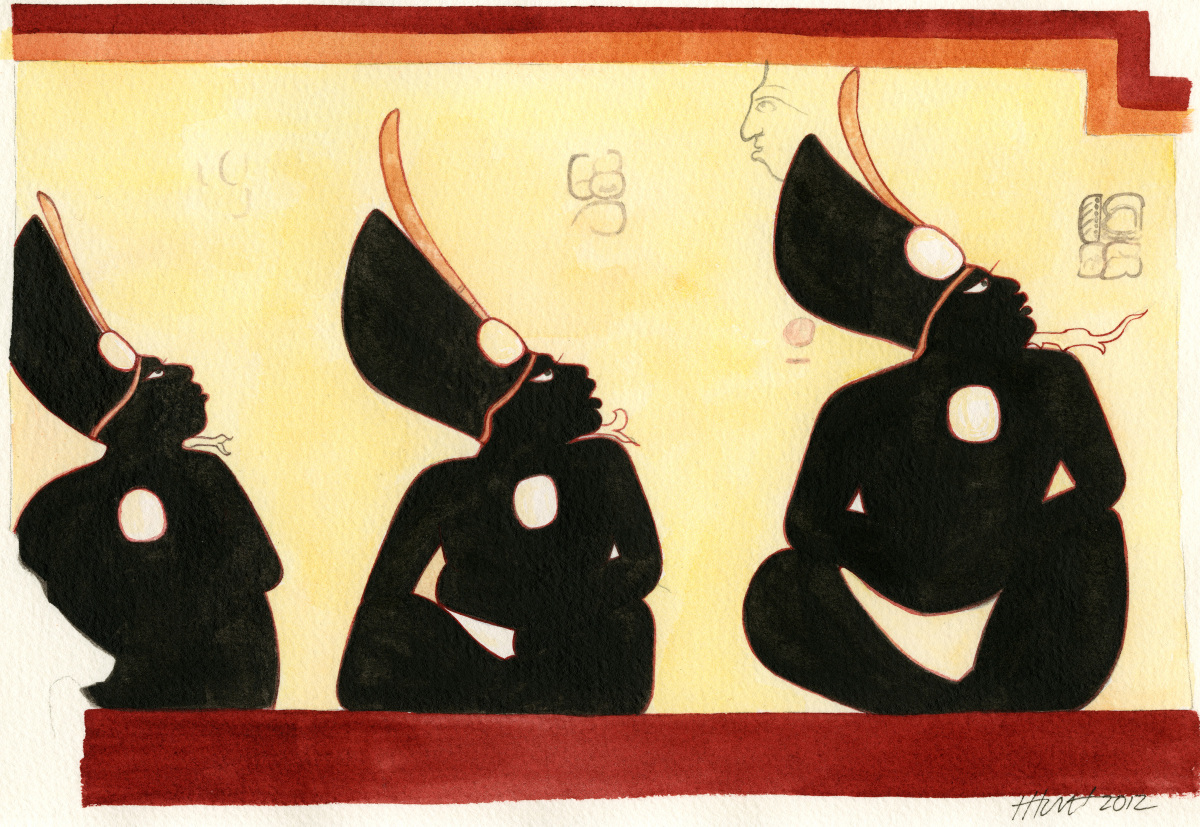

Three male figures, seated and painted in black. The men, wearing only white loincloths and medallions around their necks and a head dress bearing another medallion and a single feather, were uncovered on the ruined house's west wall. The painting recreates the design and colors of the original Maya mural. Excavation and preservation of the site were supported by the National Geographic Society. Painting by Heather Hurst
Dee Finney's blog
start date July 20, 2011
Today's date 8-8-13
page 540
TOPIC: MAYAN FRIEZE FOUND
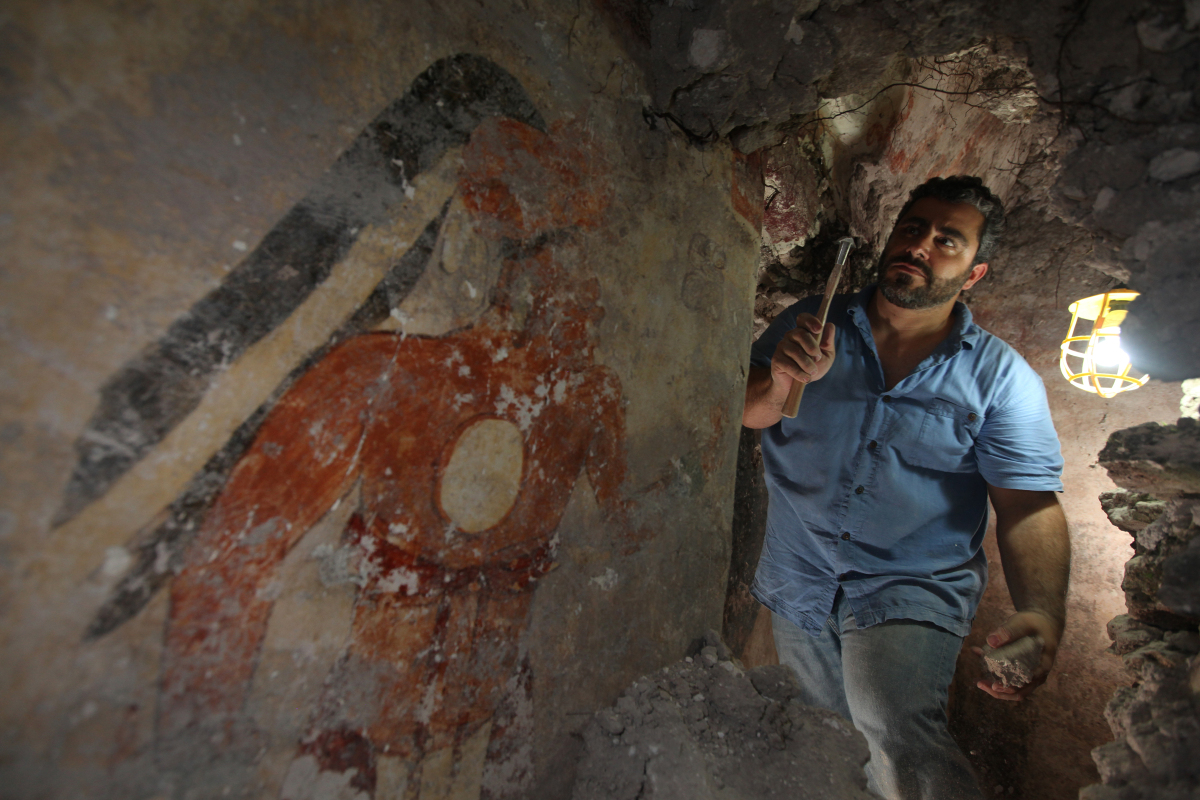
GUATEMALA CITY -- Archaeologists have found an "extraordinary" Mayan frieze richly decorated with images of deities and rulers and a long dedicatory inscription, the Guatemalan government said Wednesday.
The frieze was discovered by Guatemalan archaeologist Francisco Estrada-Belli, a professor at Tulane University's Anthropology Department, and his team in the northern Province of Peten, the government said in a joint statement with Estrada-Belli.
"This is an extraordinary finding that occurs only once in the life of an archaeologist," Estrada-Belli said.
The archaeologists were exploring a Mayan pyramid that dates to A.D. 600 in an area that is home to other classic ruin sites when they came upon the frieze.
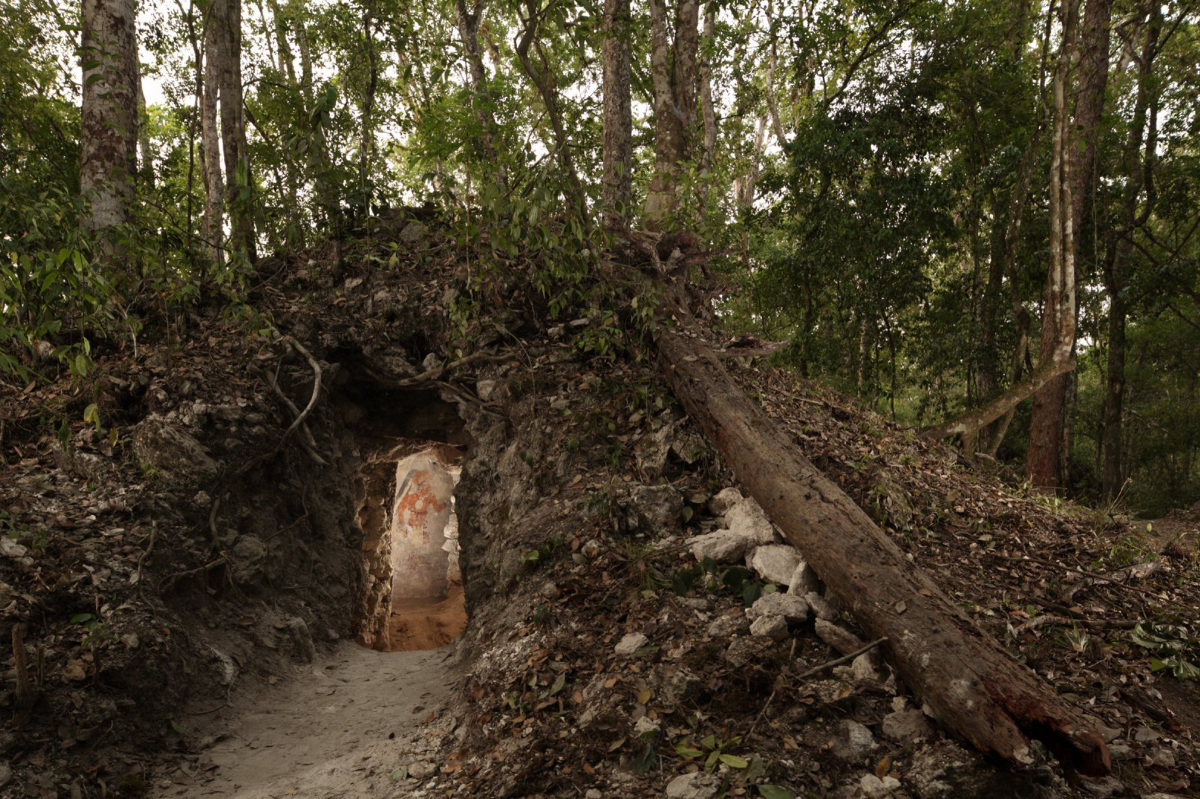
"It's a great work of art that also gives us a lot of information on the role and significance of the building, which was the focus of our research," Estrada-Belli said.
The high-relief stucco sculpture, which measures 26 feet by 6 feet (8 meters by 2 meters), includes three main characters wearing rich ornaments of quetzal feathers and jade sitting on the heads of monsters.
The frieze, which was found in July, depicts the image of gods and godlike rulers and gives their names.
The dedicatory inscription "opens a window on a very important phase in the history of the classical period," Estrada-Belli said.
The inscription is composed of some 30 glyphs in a band that runs at the base of the structure.
The text, which was difficult to read, was deciphered by Alex Tokovinine, an epigraphist at Harvard University and contributor to the research project at Holmul, the site where the frieze was found.
Tokovinine said the building was commissioned by Ajwosaj, king of the neighboring city-state of Naranjo, and vassal of the powerful Kaanul dynasty, the statement said.
David Stuart, an expert in Mayan epigraphy at the University of Texas at Austin, called Tokovinine's reading of the text "excellent."
But while the government statement called it "the most spectacular frieze seen to date," Stuart was cautious about using superlatives.
"It's really impressive," Stuart said in an email to The Associated Press. But he added, "I certainly wouldn't say this is the `most spectacular' temple facade."
"There are other buildings in Maya archaeology that are just as magnificent, if not more so," Stuart wrote, pointing out the temple called "Rosalila" at Copan, Honduras, and a building excavated starting last year at the ruins of Xultun, Guatemala, which has not yet been uncovered in full.
Also Wednesday, Guatemalan President Otto Perez Molina presented the National Geographic Society with the Order of the Quetzal, Guatemala's highest award, for their research on the Mayan civilization.
Perez Molina thanked National Geographic for its support and said the society has "put on high the cultural heritage of the Mayan civilization."
Estrada-Belli is a National Geographic Explorer. His excavations at Holmul were supported by the Ministry of Culture and Sports of Guatemala and funded by the National Geographic Society and other Guatemalan and foreign institutions.
___
Associated Press writer Mark Stevenson contributed to this report.
"Younger Brother Obsidian," as labeled on the north wall of the Maya city's house by an unknown hand, was painted in the 9th century A.D. Archaeologist William Saturno of Boston University excavates the house in the ruins of the Maya city of Xultún. Younger Brother Obsidian may have been the town scribe. Excavation and preservation of the site were supported by the National Geographic Society. Photo by Tyrone Turner © 2012 National Geographic
Trees grow atop a newly discovered mound over a house built by the ancient Maya that contains the rendering of an ancient figure, possibly the town scribe. The house sits at the edge of the ancient site of Xultún in Guatemala, a city that once housed tens of thousands of people. Excavation and preservation of the site were supported by the National Geographic Society. Photo by Tyrone Turner © 2012 National Geographic
Three male figures, seated and painted in black. (see top of page)
The men, wearing only white loincloths and medallions around their necks and a head dress bearing another medallion and a single feather, were uncovered on the ruined house's west wall. The painting recreates the design and colors of the original Maya mural. Excavation and preservation of the site were supported by the National Geographic Society. Painting by Heather Hurst
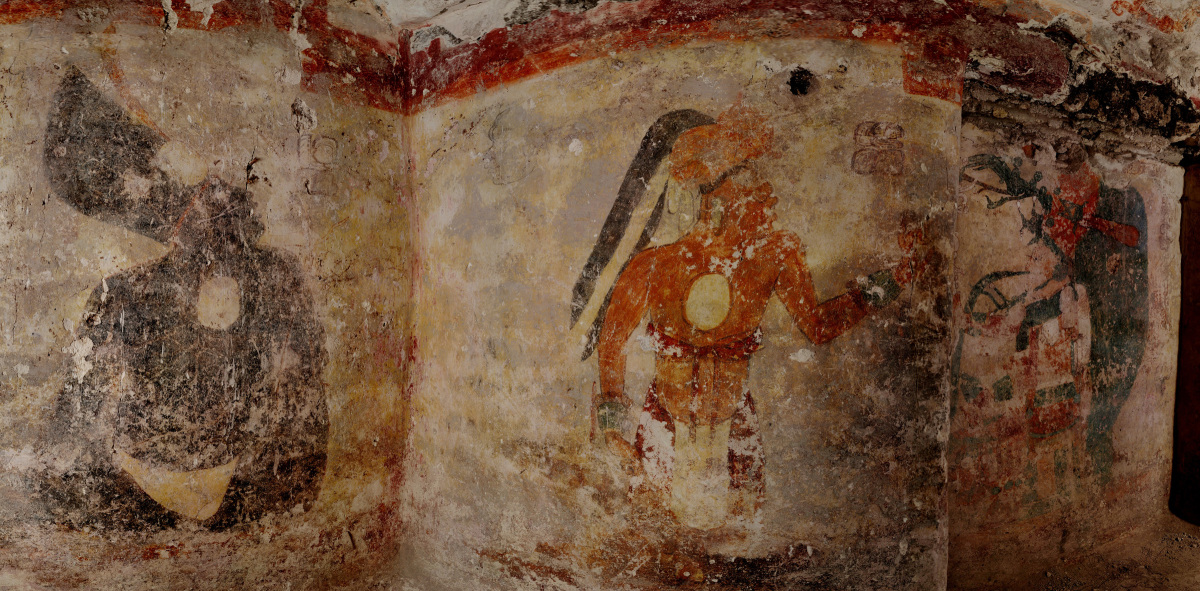
A Maya king, seated and wearing an elaborate head dress of blue feathers, adorns the north wall of the ruined house discovered at the Maya site of Xultún. An attendant, at right, leans out from behind the king's head dress. The painting by artist Heather Hurst recreates the design and colors of the original Maya artwork at the site. The excavation and preservation of the site were supported by the National Geographic Society. Painting by Heather Hurst
A vibrant orange figure, kneeling in front of the king on the ruined house's north wall, is labeled "Younger Brother Obsidian," a curious title seldom seen in Maya text. The man is holding a writing instrument, which may indicate he was a scribe. The painting recreates the design and colors of the figure in the original Maya mural. Excavation and preservation of the site were supported by the National Geographic Society. Painting by Heather Hurst
Four long numbers on the north wall of the ruined house relate to the Maya calendar and computations about the moon, sun and possibly Venus and Mars; the dates may stretch some 7,000 years into the future. These are the first calculations Maya archaeologists have found that seem to tabulate all of these cycles in this way. Although they all involve common multiples of key calendrical and astronomical cycles, the exact significance of these particular spans of time is not known. Illustration by William Saturno and David Stuart © 2012 National Geographic
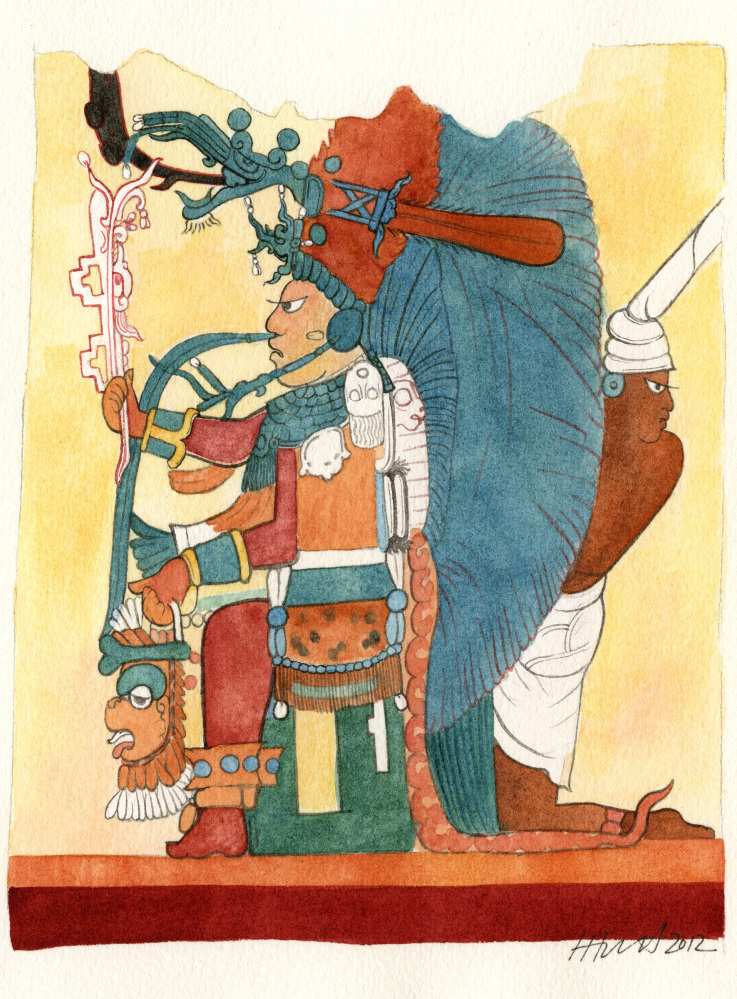
The painted figure of a man -- possibly a scribe who once lived in the house built by the ancient Maya -- is illuminated through a doorway to the dwelling, in northeastern Guatemala. The structure represents the first Maya house found to contain artwork on its walls. The research is supported by the National Geographic Society. Photo by Tyrone Turner © 2012 National Geographic
Conservator Angelyn Bass cleans and stabilizes the surface of a wall of a Maya house that dates to the 9th century A.D. The figure of a man who may have been the town scribe appears on the wall to her left. Excavation and preservation of the site were supported by the National Geographic Society. Photo by Tyrone Turner © 2012 National Geographic
Never-before-seen artwork -- the first to be found on walls of a Maya house -- adorn the dwelling in the ruined city of Xultún. The figure at left is one of three men on the house's west wall who are painted in black and wear identical costumes. Excavation and preservation of the site were supported by the National Geographic Society. Photo by Tyrone Turner © 2012 National Geographic
Archaeologist William Saturno of Boston University carefully uncovers art and writings left by the Maya some 1,200 years ago. The art and other symbols on the walls may have been records kept by a scribe, Saturno theorizes. Saturno's excavation and documentation of the house were supported by the National Geographic Society. Photo by Tyrone Turner © 2012 National Geographic
'Extraordinary' Mayan frieze found, Guatemalan government
claims ...
Giant Maya Frieze Found in Guatemala - National Geographic
News
Inside a Maya pyramid, mysterious carvings hint at superpower
...
![]() Archaeology News: Massive Maya Frieze Discovered in Buried
...
Archaeology News: Massive Maya Frieze Discovered in Buried
...
Massive Mayan Frieze Discovered in Guatemala [PHOTOS
...
Stunning Maya sculpture unearthed from buried pyramid - USA
Today
![]() Maya Sculpture Discovered; "The Most Spectacular' Depiction Of
Crowning A ...
Maya Sculpture Discovered; "The Most Spectacular' Depiction Of
Crowning A ...
We have 608 pages currently on our website about the Mayans. Here are the top few
www.greatdreams.com/mayan/mayan-calendar.htm
The Mayan Calendar was never about time, ... NOTE: I don't see any point in correlating the Mayan calendar to the English/American calendar. It's been ...
www.greatdreams.com/mayan_database.htm
He is the head of the Mayan pantheon and called 'god of the gods'. ... We are living today in the Mayan end times. The Great Cycle of the Mayan Long Count .
www.greatdreams.com/mynproph.htm
The supreme god and creator of the Maya. He is the head of the Mayan pantheon and called 'god of the gods'. Hunab Ku rebuilt the world after three deluges, ...
www.greatdreams.com/mayan/mayan-games.htm
5-30-00 - DREAM - I saw a large golden-tan letter K in the air and it began flying around in the air. I was told that there were 5 Mayan games and I should work ...
www.greatdreams.com/mayan/the-nine.htm
The Maya were also influenced by Teotihuacan that controlled the Mexican highlands from ... The Mayan golden age lasted five centuries from 300 to 800 AD.
Mayan scholars have been attempting to correlate the Long Count with our Western Gregorian calendar, since the beginning of this century. There has been ...
Description: International Mayan Peace Shaman & Poet Saint Peace Mother Geeta Sacred Song returns back to the Miami Circle after 5 years, to do ceremony ...
Jan 15, 2001 ... NOTE: After researching the number, it appears that the '26' represents the long count and the '1' represents the short count of the Mayan ...
The number 26, The Mayan Tzolkin, and the Grid Crop Circle ... of the Fifth Sun, but other researchers say it will end in 2012, when the Mayan calendar ends.".
Number 26, The Mayan Tzolkin, and the Grid Crop Circle. MAYA COSMOGENESIS 2012. MAYAN PROPHECIES AND CALENDAR. NOVELTY THEORY ...
www.greatdreams.com/end-world.htm
The Mayan calendar is divided into Seven Ages of Man. The fourth epoch ended in August 1987. The Mayan calendar comes to an end on Sunday, December ...
www.greatdreams.com/himalayan/mayacontinued.html
MAYAN CALENDAR DETAILS . click on image for larger view . . . . . .. . . 1. COMPANION AND HALE BOPP COMET-FISHING BOAT WITH WINCH FOR THE ...
www.greatdreams.com/mayan/Mayan_crystal_skulls.htm
May 23, 2008 ... Mayan: Ixchel of Fertility — As a mother goddess she was the inventor of sewing, and was portrayed as the Weaver of the World. As a wise ...
www.greatdreams.com/numbers/1111/1111mcc.htm
Aug 18, 2010 ... This page is about the meaning of the 11:11 coincidence phenomenon. It includes other numbers, such as the triplets, 111, 222, 333, 444, 555, ...
www.greatdreams.com/2012-magnetics.htm
Some Mayan groups froze their New Year to July 26, “when Sirius rises in that part of the ... Another component of the Mayan calendar is called the Long Count.
www.greatdreams.com/dresden/earth-evacuation.html
Oct 9, 2010 ... It was the story of one mans attempt to convince us he knows where the end will be best seen and that the Maya were right in their prediction of ...
www.greatdreams.com/4th-world.htm - Similar to The 4th World - and the 5th World of the Aztecs
THE 5TH WORLD OF THE AZTECS AND THE MAYANS ..... (The Mayan Prophecies, Element Books Limited, Shaftesbury, Dorset SP7 8BP (England, 1995).
www.greatdreams.com/grace/146/151tubulins.html
Jul 15, 2004 ... 27 year study in correspondences of science / religion / metaphysics. 39510 books and uncounted web sites researched.
www.greatdreams.com/numbers/1111/1111.htm
The 2012 Mayan end year is timed at 11:11 Universal time. Additional ... Significant 11:11 time associated with the 2012 end date of the Mayan Calendar.
Chatelain's Mayan calendar rendering phrases everything in terms of astrological conjunctions, which makes it obvious that the Mayans were astrologers.
www.greatdreams.com/project-omega.htm
The Mayans believed civilisation exists within a series of earth cycles of 144,000 days each with the 13th expiring in December 2012, resulting in Armageddon.
www.greatdreams.com/mayan/palenque.htm
Apr 5, 2006 ... This ancient Maya site is located at the western frontier of the lowland ... Pacal VOTAN was the Mayan prophet who lived in the seventh century ...
The Mayan cycle of time is based on 13 baktun periods of 144000 days each, for a total of 1872000 days. This amounts to approximately 5125 years. The grand ...
www.greatdreams.com/grace/100/101suntzolkin.html
Seemingly, this Author constructs the framework of the Mayan Tzolkin without realizing it. His methods validate planet placements and orbits as well as atomic ...
Jun 8, 2004 ... The Mayan civilization had a particular fascination with Venus because it was associated with their chief god Quetzalcoatl and one of his ...
www.greatdreams.com/jsswrng.htm
At this time, neither of us knew the significance of that date in the Mayan culture. In fact, Ellie knew nothing about the Mayan calendar. The next day, Ellie woke ...
www.greatdreams.com/joestuff/interp/joeindex.htm
The Mayan 11:11 Crop Circle Formation Video ... Each of the two glyphs on the bottom represent the Mayan number eleven. Could this suggest the end of the ...
www.greatdreams.com/numbers/jerry/antmec/antmec.htm
Jan 18, 2007 ... the interesting thing about all of these forms is that they are used in Mayan mythology and in their calendar systems as shown below at this web ...
www.greatdreams.com/crpcirc.htm
Leading scholars of the Mayan Calendar also teach that a new cycle will begin, as the present cycle ends. This was expressed in an ad for the 2012 Tipping ...
www.greatdreams.com/11coin.htm
We feel it is significant that the Mayan calendar ends on December 21, 2012, at 11:11 AM Universal Time (within a fraction of a minute). We have included here ...
www.greatdreams.com/tuning.htm
Many of us know that the Mayan calendar ended because it is the end of a cycle of time, [the end of Pisces and the beginning of Aquarius] and also the end of a ...
This legend tells how the two Mayan heroes defeated the earthquake god. All protection against the earthquake god. By reliving the story ritualistically, they ...
www.greatdreams.com/radio/oz/ozradio.htm
Sep 10, 2009 ... The ancient Mayans used Gematrian numbers in their very accurate timekeeping. The Code system uses mathematical constants, such as pi ...
www.greatdreams.com/himalayan/jade_skulls_found_in_china.htm
Sep 18, 2006 ... Ancient tribe of Maya passed on a legend that tells of the 13 crystal sculls able to save the world from a terrible catastrophe.
THE BEST DOCUMENTARY WE'VE SEEN ON THIS TOPIC. http://www.greatdreams.com/poleshift.htm · Singapore 2012 Crop Circle Mayan End Seminar, Part ...
Britt and Lee Elders correlated 1991 to the end of the Fifth Sun, but other researchers say it will end in 2012, when the Mayan calendar ends.
www.greatdreams.com/grace/1/2atomicorder.html
(Note: What this correspondence means, between B. Fuller's Underlying Order, and Jose Arguelles' Mayan Tzolkin, corpus collosum, mid-brain, 'cross-over' ...
www.greatdreams.com/grace/100/106primes.html
This study shows that the doubled Fibonacci Series is connected to the Mayan Tzolkin Calendar and that the Tzolkin, being a two-part mirror of itself, implies that ...
www.greatdreams.com/blog-2012-3/dee-blog386.html
Nov 26, 2012 ... In Chichen Itza in the Yucatan on 12/21/12, the calendar end date for a Mayan cycle, the Earth, the sun, and the center of our galaxy will align in ...
You will still have to live with a planet that is going crazy. This is exactly what the Mayans did when they left Atlantis during the identical problem, the shifting of ...
www.greatdreams.com/planets/saturn-myths-truths.htm
Maurice Chatelain's Mayan calendar rendering phrases everything in terms of astrological conjunctions, which makes it obvious that the Mayans were ...
The Mayan believes by the prophecy of their elders and the "Sixth Sun". The Seventh Sun is coming.The Japanese with the prophecies of "Amaterasu" returning ...
www.greatdreams.com/blog-2012-3/dee-blog379.html
Nov 17, 2012 ... Here is another video by the same Mayan teacher: http://www.youtube.com/watch ?v=-24e5XOJVjM&feature=relmfu. Watch all the Ac Tah ...
www.greatdreams.com/numbers_database.htm
THE TWO AND THE NINE - VISIONS OF THE MAYAN GODS OF THE UNDERWORLD Number 26, The Mayan Tzolkin, and the Grid Crop Circle. MAYA ...
www.greatdreams.com/calndr2.htm
MAYAN, 5119, The Mayan's use three calendars. The 5,130 year Great Cycle ends on the Gregorian year 2012. The Maya based their original calendar on the ...
www.greatdreams.com/nine/nine.htm
"9 is the number of the mythic Lords of Time, the number representing the original Mayan galactic masters themselves." - Arguelles, The Mayan Factor.
www.greatdreams.com/blog-2012/dee-blog110.html
Jan 17, 2012 ... The Maya use of sacred celestial waters within the pyramids for healing and longevity is an open invitation to sacrifice the false comforts of ...
www.greatdreams.com/darkness/coming-darkness.htm
Using this premise, there are several possible supportive facts for 2009 as the beginning of sorrows, including that the end of the Mayan calendar, December 21, ...
www.greatdreams.com/numbers/code-ages/gem14.htm
I started with 2012 C.E., the end of the Mayan calendar cycle, and subtracted 2160 years, for the beginning of Pisces at 148 B.C.E. Angle DE in the Barbury ...
www.greatdreams.com/numbers/09-09-09.htm
Sep 9, 2009 ... Nine Cosmic levels (Underworlds) that according to the only existing Mayan inscription about the calendar end date (Tortuguero monument 6) ...
www.greatdreams.com/grace/50/55magsqlev.html
Magic Square, Mayan Tzolkin, 13 / 20 Permutations This represents. THE Code of Light permutations. This magic square pertains to light (electrons, Tzolkin) ...
www.greatdreams.com/reptlan/reptilian_hierarchy.htm
May 10, 2009 ... The Mayan pyramids, their advanced astronomical technology and ... He added that these reptilians interbred with the Mayans to produce a ...
www.greatdreams.com/climate/apotheosis.htm
It comes 1260 days before December 21, 2012 — the day the Mayan calendar ends. Is the Apotheosis truly at hand? Is World Government here? Are the Two ...
497 - 153 = 344, which is always July 4th on the Mayan Haab Calendar, because Day Number 360 is always July 20th. (I will note here that the 153rd course of ...
www.greatdreams.com/blog-2012-3/dee-blog346.html
Oct 22, 2012 ... One side of the Santena crop picture showed four inner planets on a date of December 21, 2012, which is an end to the Mayan Long calendar.
www.greatdreams.com/reptlan/pindar.htm
The known shape shifting in human mythology goes back to North Africa, Tibet, Maya, Rome [called versae pellis effect]. The Reptile species is apparently on a ...
www.greatdreams.com/500-trumpets.htm
THE TWO AND THE NINE - VISIONS OF THE MAYANS GODS OF THE UNDERWORLD · THE 11:11 experiences. A CHRISTIAN PERSPECTIVE. ...
www.greatdreams.com/time_cycle_database.htm
The Mayan periods/cycles of Time known as SUNS. Some sources cite we are in 4th Sun and some cite 5th Sun. These are the same depending upon if you ...
www.greatdreams.com/guatemala-earthquake-61307.htm
This legend tells how the two Mayan heroes defeated the earthquake god. .... everyone of today's scientists has been going to the jungles of Guatemala in .
www.greatdreams.com/reptlan/giants.htm
www.greatdreams.com/26.htm . MAYAN PROPHECY ... Bacabs. In Mayan mythology, a group of four protective deities, the sons of Itzamna and Ixchel. They are ...
www.greatdreams.com/numbers/72/72.htm
Sep 4, 2011 ... The ancient Mayans used Gematrian numbers in their very accurate timekeeping. The Code system uses mathematical constants, such as pi ...
www.greatdreams.com/poleshift.htm
The 5-pointed star has long been connected to Venus, Jesus, Satan, and the Mayan connection to the year 2012. Read article above. It is also connected to the ...
www.greatdreams.com/grace/1/36closerlook.html
It is no mere coincidence that we count in base 10 decimal while the Mayan Calendar is base 2 (20) vigesimal, or the number 20 of Buckminster Fuller, or the ...
www.greatdreams.com/moon_database.htm
The Mayan earth and moon goddess and patroness of pregnant women. ... And, it was believed that a rabbit could change its sex—like the moon.
I knew that Chichen Itza was a site of Mayan step - pyramids, and that there was evidence tracing them to Atlantis. Sitting up in bed, I had just realized that Joe's ...
www.greatdreams.com/grace/indexes/pdf.html
By Michael Heiser. * Lost. Smelyakov.pdf (doc, large 605KB) THE AURIC TIME SCALE AND THE MAYAN FACTOR by Sergey Smelyakov, Yuri Karpenko. * Lost.
www.greatdreams.com/pole_shift_database.htm
Crawford 2000 A Disussion of the Mayan calendar, 2012, 2011, pole shift, ... Earth Pole Shift 2012 & 13.0.0.0.0. Keith Hunter theorises that a pole shift is .
www.greatdreams.com/blog/dee-blog57.html
Oct 25, 2011 ... Mayan elders with the 13 crystal skulls gathered in Manhattan, NYC to start the Oct 27 ... The World, Liberation, Mobility ( moving of the Mayan
www.greatdreams.com/dna_database.htm
Our DNA during the Mayan cycles of the last 26000 years has been encoded with ... The Mayan scholar, Hunbatz Men, says that a repair of DNA will take place.
Dec 3, 2000... is also coming to its end co-inciding with the predicted ending date of August 12th, 2012 for the acurate and legendary Mayan Calendar.
www.greatdreams.com/pleiades/7sisters.htm
Apr 14, 2000 ... The Maya say the solar system rotates around Alcyone in a 26,000 period. ... Another Mayan 26,000 year cycle is based on the Pleiades star ...
www.greatdreams.com/comets/comet-elanin.html
Aug 16, 2011 ... Especially since this is right before the true 13 Ahau culmination date of the Mayan calendar (October 28, 2011), this comet is, regardless of the ...
www.greatdreams.com/lostland/string-pearls.htm
With the work of Dr. S.V. Smelyakov and Y. Karpenko on the Mayan Calendar [6], we may well have the "smoking gun" to prove scientifically that a fundamental ...
www.greatdreams.com/end_time_flood.htm
Jul 24, 2002 ... For the ancient Maya, the cross represents both the constellation of the Southern Cross and the "Sacred Tree" its four branches analogous to ...
www.greatdreams.com/twosuns.htm
Then, in terms of the Mayan calendar, we were less than two heart-beats from eternity. The Magic Square of the Sun. In Greek Gematria, Helios, the physical sun ...
www.greatdreams.com/grace/1/14spacepatterns.html
This numerator 6563 (6561) is also a Mayan Super-number orbital frequency in the Balmer Series of orbitals. It is also found in the File "26 Keely".
www.greatdreams.com/return_of_the_dove.htm
The map points to the Yucatan Peninsula - Quetzalcoatl and Mayan Calendar Prophecies. This area is being hard hit by earth changes - washing things away.
www.greatdreams.com/india_database.htm
(Brazil), Nagasaki (Japan), Mul (England), Maya (Russia, Naga (India), and Chukotz ... THE TWO AND THE NINE - VISIONS OF THE MAYAN GODS ...
www.greatdreams.com/grace/50/77lethpend.html
The number 40, I believe, has something to do with the cycle length, in base 16, just as vegismal 20 of Mayan cosmology is base 6, 12 is base 9 and 60 of the ...
www.greatdreams.com/sacred/cut-banded-tree-two.htm
May 9, 2009 ... The Maya of southern Mexico and Guatemala associated Orion's sword with their creator ... The Mayan hearth was a triangle of three stones.
www.greatdreams.com/grace/50/93overall.html
The Mayan system of the Tzolkin magic squares. The numbering of the pattern of spheres. The Mayan Tzolkins of magic squares of various sizes which ...
www.greatdreams.com/anunnaki/grandma-nammu.htm
August 13, 3113 -- Day One of the Mayan calendar's “Long Count” (ending in ... C.E. 200 -- Beginning of the “Classic” Mayan period (and lasting until C.E. 900).
May 24, 2002 ... Our DNA during the Mayan cycles of the last 26,000 years has been ... The Mayan Daykeeper, Hunbatz Men, has been teaching that a very ...
www.greatdreams.com/radio/ryan/1111/ryan1111.htm
The end of the Mayan calendar falls on December 21, 2012. That is the famous " End Date." (See http://www.levity.com/eschaton/Why2012.html) (2) Stan's ...
www.greatdreams.com/himalayan/desisto-skulls-2.html
Joshua Shapiro reports: The places where the human sized ancient crystal skulls have been found is Indian ruins (Mayan, Aztec, etc....) in Mexico or Central ...
www.greatdreams.com/sacred/morning_star.htm
See: Mayan Prophecy of the End of the Great Cycle http://www.greatdreams.com/mynproph.htm . [excerpt] Quetzalcoatl translates to plumed serpent. The word ...
www.greatdreams.com/apache/Chronology-1830-1890.htm
Mayan ruins rediscovered in Central America by John Lloyd Stephens and Frederick Catherwood. 1841-42. John Charles Fremont (U.S.) explores the Far West ...
www.greatdreams.com/grace/100/119ddt.html
The Mayan calendar cycles, Saros cycles, Metonic cycles...et al,. Studies of universal expansion of waveforms from "The Word", or Sound of the Origin,.
www.greatdreams.com/grace/100/125greb.html
The conclusion is that the Fibonacci Series found in the myalin sheath of nerves is related to Phi, which is tuned to the "Other Side" and to the Mayan Tzolkin, ...
www.greatdreams.com/haarp_database.htm
The Mayan Calendar predicted all the changes that are occuring now. ... www. greatdreams.com/haarp-sun.htm ... www.greatdreams.com/mayan_database.htm ...
www.greatdreams.com/drought_database.htm
The Mayan signs of the south, Kan, Lamat, Eb, Cib, ... ... www.greatdreams.com/ drought_and_heat. ... www.greatdreams.com/mayan_database.htm ...
www.greatdreams.com/illuminati_database.htm
(Mayan Calendar is 5125 years in length and comes into "alignment" in 2012, only eight years before the Illuminati plan for when their "New World Order" .
www.greatdreams.com/pyramid_database.htm
With all the links between the Pyramid's timeline and the Mayan Calendar cycles, ... It started out like a pyramid with a flat top, then went back at the .
www.greatdreams.com/prophecy.htm
OF THE AZTECS AND MAYANS. 9-12-03 - 30% CHANCE THAT YELLOWSTONE SUPERVOLCANO IS GOING TO BLOW ITS CORK WITHIN 6 MONTHS.
THE MAYANS. Chichen Itza · Monastery of Izamal, Yucatan, Mexico · Pyramid of Kulkulkan/Quetzalcoatl Chichen Itza, Yucatan, Mexico · Pyramid of the Magician ...
www.greatdreams.com/astrology_database.htm
Chatelain discovered that the Mayan Calendar was actually based on astrology ... It may be helpful to recognize that all calendars, including the Mayan calendar ...
www.greatdreams.com/connect.htm
The Number 26 - The Mayan Connection · "The Symbolism and Spiritual Significane of the Number 17 & 36" · 49 The Levels of Consciousness / connected to ...
www.greatdreams.com/contents.htm
THE TWO - THE NINE - THE MAYAN GODS OF THE UNDERWORLD · MAYAN GAMES - THE MAYANS SACRIFICED THE WINNERS AND THE LOSERS OF ...
THIS IS WHERE I POST WHAT I'M DOING AND THINKING
BLOG INDEX 2011
BLOG INDEX 2012 - page 1
JANUARY THRU APRIL 2012
MAY THRU AUGUST 2012
SEPTEMBER THRU DECEMBER
BLOG INDEX 2013
BLOG INDEX - PAGE 2 - 2013